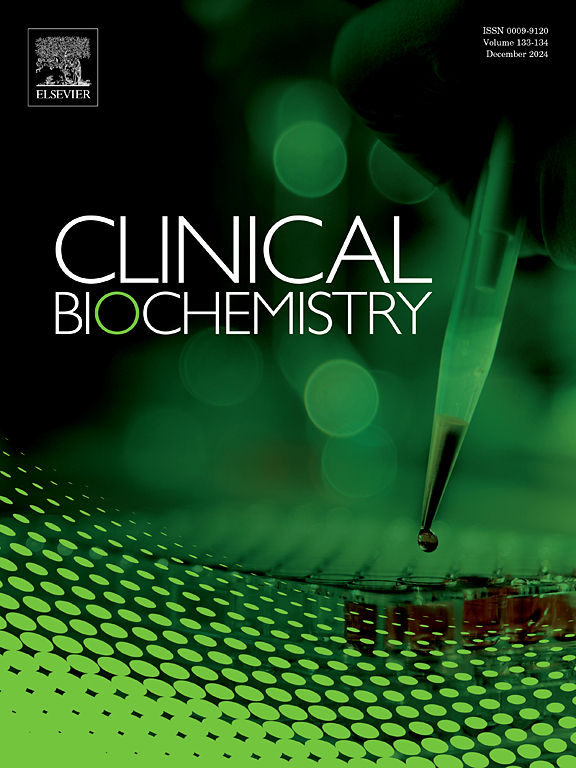急诊感染诊断的生物标志物分析:一项评估c反应蛋白、降钙素原、俱乐部细胞蛋白16、白介素-6、几丁质酶样蛋白和可溶性尿激酶型纤溶酶原激活物受体的诊断研究。
IF 2.1
3区 医学
Q2 MEDICAL LABORATORY TECHNOLOGY
引用次数: 0
摘要
简介:在急诊科(EDs)诊断感染对及时有效的治疗至关重要。本研究评估了六种炎症生物标志物cc16、CRP、IL-6、PCT、suPAR和ykl -40在ED疑似感染患者中的诊断准确性。材料和方法:这是一项多中心诊断准确性研究。在四家丹麦急诊科怀疑感染的成年患者被纳入研究。我们测量了入院时的生物标志物水平,并分析了它们的诊断性能。结果:纳入966例患者,确诊感染789例(81.7%)。CRP、IL-6和PCT表现出最高的阳性预测值,分别为93% (95% CI, 91-95)、92% (95% CI, 90-94)和91% (95% CI, 88-93)。然而,这些指标的阴性预测值较低,约登指数分别为35.5 (95% CI, 30.8-40.5)、38.3 (95% CI, 32.5-44.3)和34.2 (95% CI, 28.9-39.9)。CRP、IL-6和PCT的预测能力最强,其中CRP的曲线下面积(AUC)为0.79。IL-6和PCT的准确度相近。CC16、suPAR和YKL-40的auc值在0.53 ~ 0.64之间。CRP水平在症状出现后3天达到峰值,而PCT水平在症状出现和入院时最高。结论:CRP、IL-6和PCT的诊断准确率最高,但受症状出现时间和发热的影响。CC16、suPAR和YKL-40的诊断准确性较差,被认为是较差的鉴别器。总体而言,没有单一的生物标志物足以最终确定是否存在感染。这些发现支持在使用生物标志物诊断ED感染时需要细致入微的解释。本文章由计算机程序翻译,如有差异,请以英文原文为准。
Biomarker profiling for infection diagnosis in emergency departments: A diagnostic study evaluating C-reactive protein, procalcitonin, Club Cell Protein 16, interleukin-6, chitinase-like protein, and soluble urokinase-type plasminogen activator receptor
Introduction
Diagnosing infections in emergency departments (EDs) is vital for prompt and effective treatment. This study evaluates the diagnostic accuracy of six inflammatory biomarkers—CC16, CRP, IL-6, PCT, suPAR, and YKL-40—in ED patients with suspected infections.
Materials and methods
This was a multicenter diagnostic accuracy study. Adult patients suspected of infections at four Danish EDs were included. We measured biomarker levels at admission and analyzed their diagnostic performance.
Results
The study included 966 patients, with 789 (81.7%) confirmed infections. CRP, IL-6, and PCT demonstrated the highest positive predictive values, recorded at 93% (95% CI, 91–95), 92% (95% CI, 90–94), and 91% (95% CI, 88–93), respectively. However, the negative predictive values of these markers were low, at 35.5 (95% CI, 30.8–40.5), 38.3 (95% CI, 32.5–44.3) and 34.2 (95% CI, 28.9–39.9) respectively at Youden Index. CRP, IL-6, and PCT were the most predictive, with CRP demonstrating an area under the curve (AUC) of 0.79. IL-6 and PCT showed similar levels of accuracy. CC16, suPAR, and YKL-40 displayed AUCs in the range of 0.53–0.64. CRP levels peaked three days after symptoms appeared, whereas PCT levels were highest upon symptom onset at admission. The influence of fever enhanced the sensitivity of IL-6 and PCT.
Conclusion
CRP, IL-6, and PCT showed the best diagnostic accuracy among the biomarkers tested but are influenced by the timing of symptom onset and fever presence. CC16, suPAR, and YKL-40 had poor diagnostic accuracy and were considered poor discriminators. Overall, no single biomarker was sufficient to conclusively rule in or rule out infection. These findings support the need for nuanced interpretation when using biomarkers to diagnose infections in ED settings.
求助全文
通过发布文献求助,成功后即可免费获取论文全文。
去求助
来源期刊

Clinical biochemistry
医学-医学实验技术
CiteScore
5.10
自引率
0.00%
发文量
151
审稿时长
25 days
期刊介绍:
Clinical Biochemistry publishes articles relating to clinical chemistry, molecular biology and genetics, therapeutic drug monitoring and toxicology, laboratory immunology and laboratory medicine in general, with the focus on analytical and clinical investigation of laboratory tests in humans used for diagnosis, prognosis, treatment and therapy, and monitoring of disease.
 求助内容:
求助内容: 应助结果提醒方式:
应助结果提醒方式:


